Geoff Nicholson's Blog, page 16
April 6, 2022
I WOULD WALK 500 STEPS ... AND SO ON
This is Peta Bee:

A little while back she had a piece in the Times Weekend Section – ‘Why walking is the best midlife exercise. Peta Bee on how many steps you really need.’
It was variations on the usual flannel – ‘Improve the scenery to improve your pace,’ ‘Walk faster,’ ‘Complement walking with weights,’ - but there was an interesting part in which she quoted someone called Thomas Yates who is – wait for it - a professor in ‘physical activity, sedentary behavior and health.’ Imagine that. I suppose later in his career he may become a professor just of sitting about.
The quotation runs as follows, ‘If you are someone who is very sedentary then increasing you daily walk by 500 steps or just aiming for five minutes of continuous walking would be enough to provide a reasonable health boost.’
You see that. You don’t actually have to DO it. You just have for AIM to do it.
However, according to a sign currently displayed at the Barbican Centre, the government takes a different view –
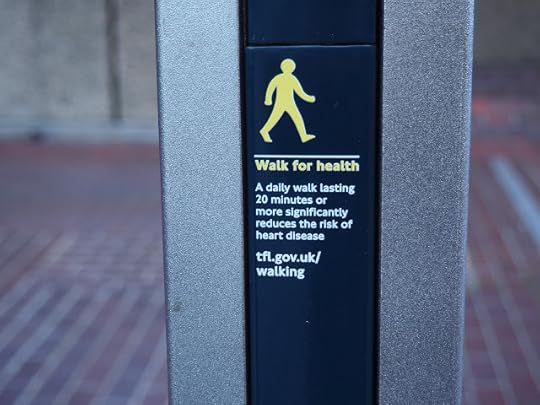
They say you need ‘a daily walk lasting 20 minutes or more to reduce the risk of heart disease,’ though they don’t say how MUCH more than 20 minutes. And of course it doesn’t say you actually reduce heart disease, just RISK or heart disease.
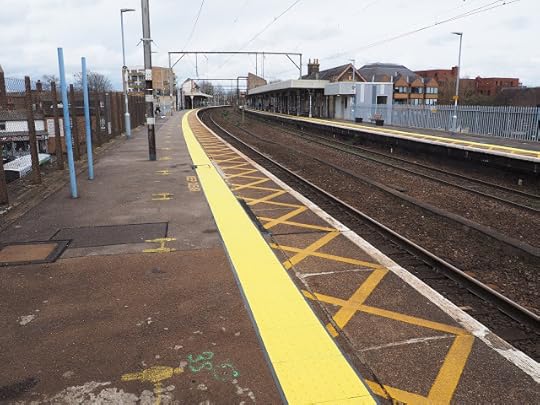
Now, if you find yourself between trains at Chelmsford station, as I did recently, you’ll have the time to walk from one end of the platform to the other. In fact you’ll have time to walk from the middle, where the platform entrance is, to one end, back to the middle, down to the other end and back to the middle again.
I’d estimate that the platform is 250 yards long, so that’s your 500 steps right there, though it seemed to take me longer than 5 minutes.

In fact if you’re at Chelmsford station and your train is cancelled you’ve got a good half hour to walk back and forth, do you 500 steps and then a great many more. That must begged for your health, though that's not why I walk.
And at the southern end of the platform there was a sign, in fact a use of language, in fact a concept, that I’d never seen before:
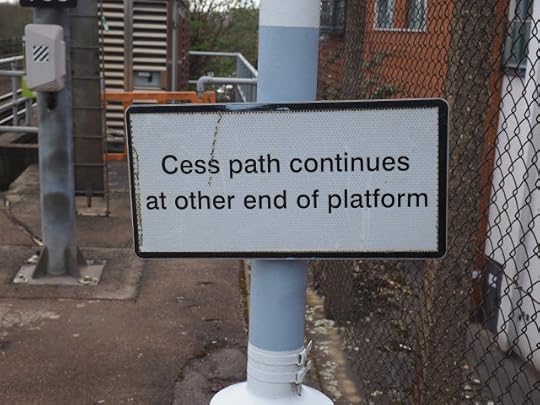
‘Cess path continues at other end of platform.’
I'd never seen the term 'cess path' before. It was the kind of thing that makes a walk worthwhile. Strange that it's not a category of experience mentioned in Peta Bee’s article.
March 26, 2022
BETAVILLE
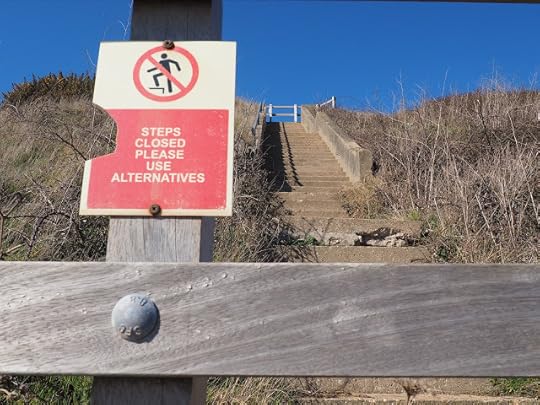
I don’t often feel like a character walking through a Jean Luc-Godard film, but it sort of
happened the other day in Felixstowe.
The film in question was Les Carabiniers (1963) in which two idiot brothers go off to war, having been promised that they can take all the loot and plunder they want.
"Will we be able to slaughter the innocent?"
"Of course, this is war."

When the war is over they return home, and the only loot they have is a collection of postcards, showing the Parthenon, the Taj Mahal, Liz Taylor as Cleopatra, and so on.

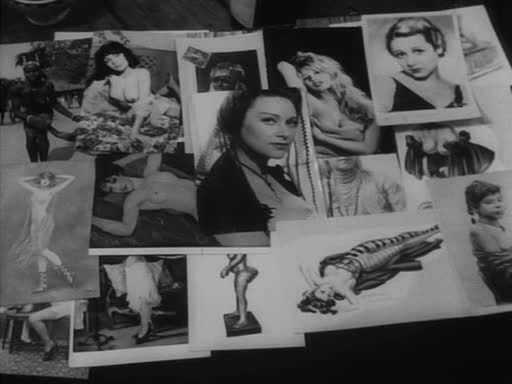
Now, because I have a deep affection for dying forms, I also have a deep affection for postcards. I’m not a collector, more of a small time accumulator and I happen to have one that shows ‘Hamilton Cliffs and Gardens, Felixstowe.’
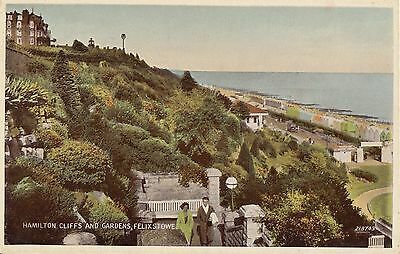
I no longer remember where or when I acquired it – the back is blank and I assume I picked it up in a junk shop somewhere. This postcard image was on my mind as I walked in Felixstowe. The Hamilton Gardens now seem to be merged with the Seafront Gardens; certainly I couldn’t tell where one ended and the other began.

And there were also the Cranmer Cliff Gardens, which were fenced off and inaccessible and looked as though they might once have contained grottos and possibly hermits.

Of course we didn’t only walk in the gardens. We went as far as the Felixstowe Ferry – passing two Martello towers on the way. Also an unexpectedly Ballardian lagoon.

And I tried, not very hard, to buy a postcard but I couldn’t see anything that was as good as the old one I have.
I suppose Les Carabaniersis a film about how some of us are just as much in love with the images of things as we are with the things themselves. I still don’t know if that’s a bad thing or not.
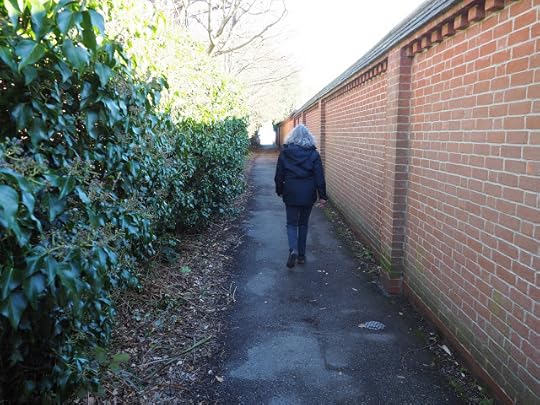
March 22, 2022
NUCLEAR WALKING
I recently watched the movie Can You Ever Forgive Me?(2018).

It stars Melissa McCarthy and Richard E Grant, and it’s about Lee Israel who forged literary letters and manuscripts in New York in the 1990s. And the answer to the question in the title is of course we can forgive you. It’s Melissa McCarthy and Richard E Grant. If it had been Nicole Kidman and Steven Segal, then probably not.
There’s not a whole lot of walking in the movie though there is a little

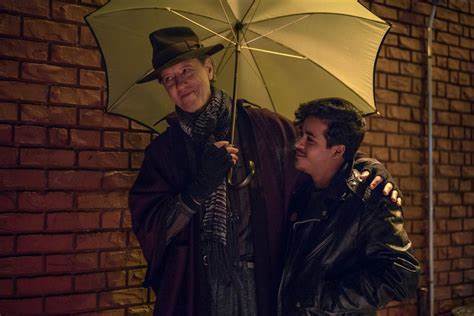
and at one point Paul Simon pops up on the soundtrack performing ‘Can’t Run But’
It’s from the era when Simon thought he was a great wordsmith, but the ‘poetry’ is interspersed with a catchy chorus which runs ‘I can’t run but I can walk much faster than this’ which is OK – I don’t ask for profundity in the popular song.
But of course the ear pricks up at the verse
A cooling system
Burns out in the Ukraine
Trees and umbrellas
Protect us from the new rain
Armies of engineers
To analyze the soil
The food we contemplate
The water that we boil
Here’s a picture of Paul Simon walking:

This is certainly not the only song to mention ‘the’ Ukraine – Giant Sand’s ‘Solomon’s Ride’ also gives it a mention –
Solomon fell in love by letter.
A brain surgeon he never met out
In the Ukraine
Gave it all up here and went out to go get her
Last time I saw him he was making
A run for the plane.
So I suppose Solomon wasn’t actually walking at that point.
Here’s a picture of Howe Gelb walking, more or less.

And here are some people walking in Chernobyl a few years back – nuclear tourists. Ah, the good old days.
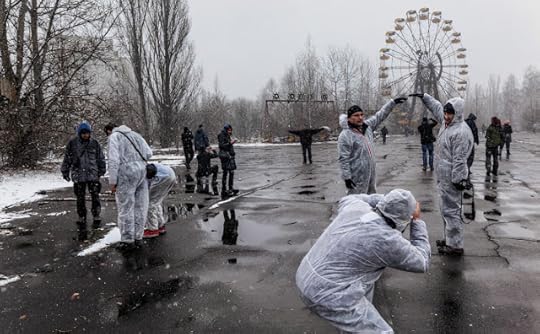
March 6, 2022
BRAVE MEN AND WOMEN
War involves endless movement, getting civilian and military personnel from one place to
another, getting to the right place and escaping from the wrong place Very often
machines are involved – cars, trains, tanks, planes, armoured vehicles. And yet for many,
especially (though not exclusively) refugees, war involves a great deal of walking.
These are Ukrainians:

These are Afghanis:

These are Rohinya refugees:

And obviously it's not just civilians. In the Falklands. British soldiers referred to ‘yomping.’
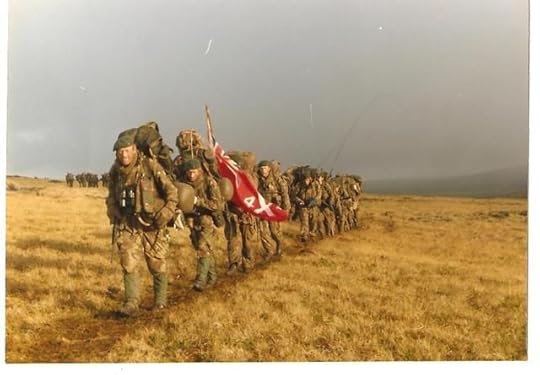
My dad was in his teens when Sheffield was bombed in World War 2. The day after a round of bombing he still went to work, walking over bodies on the way.

In the same week that a war started in Europe there was a piece in the papers about researchers in Canada who had discovered that - and I'm quoting from the Times here 'that the prevalence of obesity among adults living on "highly walkable" neighborhoods was 19% lower than in those living in areas with 'low walkability.'"
And yeah, you might think, trivial First World problems, although until recently we tended to believe that Russia and Ukraine were firmly in that first world.
Also at times like this it might be reasonable to remember Ed Ruscha's line, (which I don’t imagine he invented) the phrase ‘Brave Men Run in My Family.’

February 20, 2022
"NOTHING ENDURES BUT CHANGE"
Who could disagree with Heraclitus when he said, “No man ever steps in the same river
twice, for it’s not the same river and he’s not the same man.” (Incidentally, “steps” is
sometimes translated as ‘walks,’ but that sounds off to me. I mean who walks in a river?
Wade at best).
Anyway it seems to me that Heraclitus’s notion applies to streets as well as rivers, though judging by this picture, old H. found walking a bit of a strain. Scholars are reasonably sure that he suffered from dropsy.

Living as I do in small town Essex there’s a strictly limited number of nearby streets to walk down. Even so, by definition, and not just Heraclitus’, every street is different every time I walk down it, as am I. And I think you can say something similar about photography: you can’t photograph the same subject twice because the subject will have changed, as will the photographer.
There’s a certain street I walk down reasonably often and the first time I did it I was taken by this strange and interesting and rather attractive juxtaposition of plant life and dog statue.

A year or so later it looked like this.

I wasn’t sure what had happened to the plants but, as you see, snow was on the ground, and it did occur to me that the plant might have simply come to the end of it’s life or perhaps just receded for the winter. I suppose a better plantsman would be able to tell you the names of the absent plants.
And then, not so long ago, I walked down the street again and things had taken chaotic a turn – no snow, no plant, and a significant pile of rubbish. The dog, however, endures, for now.
February 10, 2022
WALKING AND FIELDING

I’ve been sorting my books – not ‘unpacking my library’ – I did that years back but
I’m still trying to find a reasonable order for them.
And I happened to find my copy of The London Mob: Violence and Disorder in Eighteenth-Century England (2004) by Robert Shoemaker. I opened it not quite at random and came across this extraordinary passage:
‘In 1776 John Fielding warned new arrivals to the city of the dangers of walking at night: “he will sometimes be liable to the more dangerous attacks of intemperate rakes in hot blood who occasionally by way of bravado, scower the streets, to shew their manhood, not their humanity; put the watch to flight; and now and then have murdered some harmless and inoffensive person.”’
The passage is illustrated by the engraving (anonymous as far as I can tell) ‘High Life At Midnight’ which is at the top of this post.
Shoemaker could have had left it there, but he goes on:
‘The common themes of these attacks, which were public, unprovoked, committed by elite young men, often targeted at strangers (especially young women), involved an element of playfulness and were often described using the imagery of blood, suggest that the perpetrators were adolescents, possibly confused about their sexuality ..’
Well thanks Bob, that explains everything.
This is Sir John Fielding
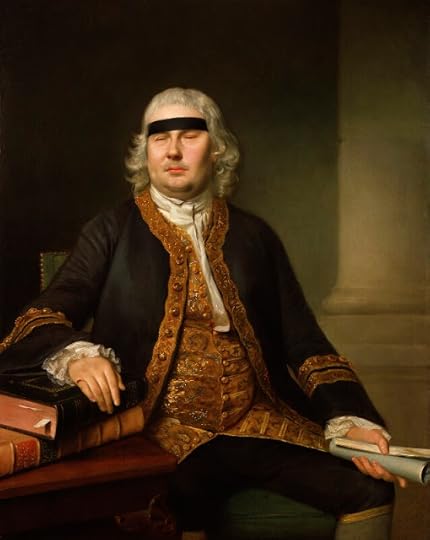
I don't know how much of a walker he was but he was an amazing man; half-brother of Henry Fielding (together they set up the Bow Street Runners), blinded in a naval accident at the age of 19, became a magistrate known as the Blind Beak and was supposedly able to recognize 3,000 criminals by the sound of their voices.
January 31, 2022
STANMORE SAUNTERING

You want to know why Modernist architecture never really took off in England? I’ll tell you
why Modernist architecture never took off in England. It’s the lack of blue skies, which is
perhaps also to say lack of sun.
I was walking in Stanmore last week, peering at some modernist houses (only the outsides) with flaneuse and professional walking tour guide (Jen Pedler) and we arrived in the morning when the sky was grey and there was rain in the air.


It was easy enough to see that these houses on Kerry Drive and Valencia Road, designed in the 1930s, were architecturally special but under a low grey sky they really didn’t look as fantastic as they might have.
In fact the houses are mostly built of brick and coated with Snowcrete which is still easily available. I wonder if a pure Modernist might think that was cheating.

So we wandered around Stanmore, looking at this and that, and we ended up in the Stanmore Country Park, which was surprisingly muddy in places but worth it because in the end we got this extraordinary view of London – in fact it’s called the London Viewpoint.
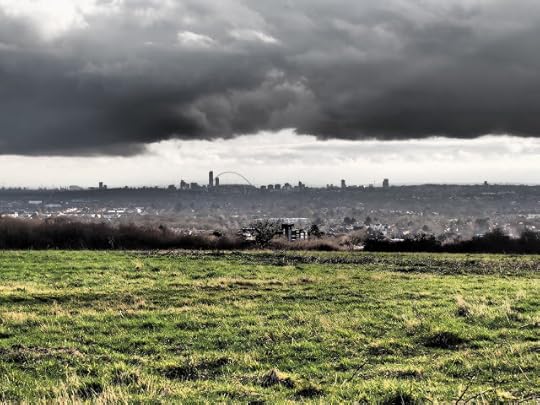
While we were up there the sky brightened and by a circuitous route we returned to our starting point, by which time the sun was out, the sky was blue, and the Modernist houses looked absolutely magnificent.


Of course whiteness isn’t everything. We had also taken a detour to see the house at 2, Aylmer Close, designed by Gert Kaufman in the sixties (he also designed one of the houses in Kerry Avenue).
It looks like this; not so much modernist as Brutalist
 From Pinterest
From PinterestNot that we saw it with our own eyes. The owners obviously want their privacy, and the best view we could get of it was this:
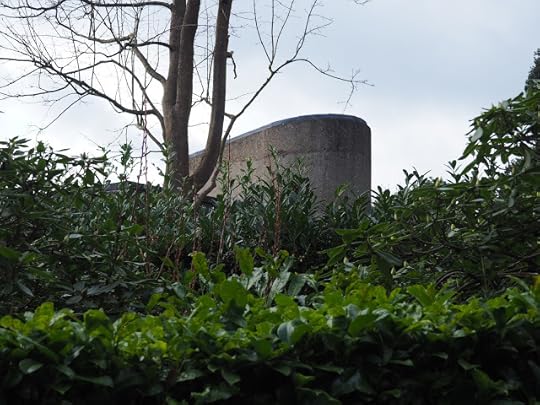
Other attractions in Stanmore, well I can’t guarantee it’ll be there for long, but this car on Stanmore Hill, a Buick Eight:
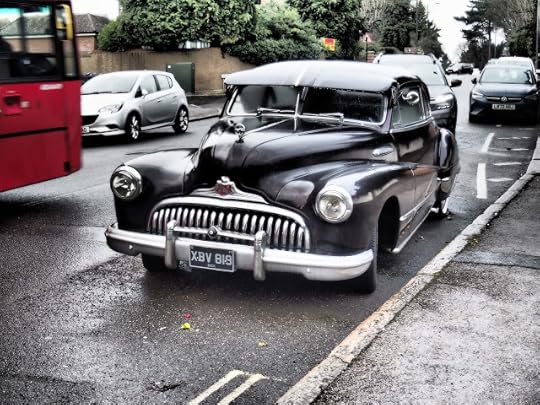
It’s cool enough in itself but the rear number plate said “A Quinn Martin Production. Quinn Martin was the producer behind The Fugitive, The Streets of San Francisco, Cannon among many other fine TV shows.

What Quinn Martin's name (and just conceivably his car) were doing in Stanmore, I have no idea; but there is this:

January 24, 2022
I'M NOT AFRAID OF VIRGINIA WOOLF, JUST A BIT WARY
 Mrs Dalloway in a hat
Mrs Dalloway in a hat I’ve been trying again to read Virginia Woolf’s Mrs Dalloway. I’ve tried before and I gave it up as a bad job, but this time I got to the end of it. It confirmed, what I already knew, that Virginia Woolf and I are not destined to be soul mates.
Mrs Dalloway has a reputation for being something of a walking novel. In Flaneuse Lauren Elkin says, ‘Mrs Dalloway is perhaps the greatest flaneuse of twentieth-century literature.’ She was wise to put in ‘perhaps,’ I’d say.
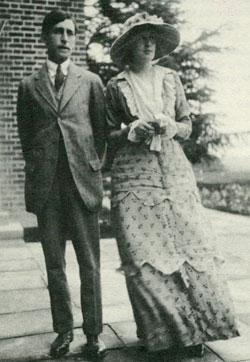
True, Mrs Dalloway does do a bit of walking - she goes out to buy flowers because the servants are too busy preparing for her party (really - 'What a lark. What a plunge!'), but it’s a very short walk; she’s home by 11 am, apparently walking for an hour at most, and John Sutherland has pretty convincingly argued that she takes a taxi home.
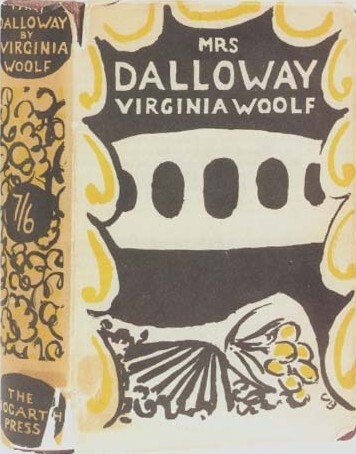
But there’s a interesting line in the book.
The line is unchanged from the way it appeared in the original short story version of the opening section, published in The Dial, in 1923, titled ‘Mrs Dalloway in Bond Street.’
I do wonder if this was an unusual or even a startling or subversive thing for a woman (or anybody) to think and say in 1923 (short story) or 1925 (novel).
We do know that Woolf had read, or had tried to read, Joyce’s Ulysses (1922-ish), but she didn’t rate it because it was written by a ‘a self-taught working man’ – self taught at University College Dublin.
And I suppose it’s possible that Woolf was aware that Baudelaire described the flâneur in his essayThe Painter of Modern Life (1863), but I think it’s highly improbably that Mrs. Dalloway was.
Fortunately, there is some fabulous unintentional humor in the novel, which had me shorting Guinness through my nose
Mrs. Dalloway is not the only walker in the book. Her daughter walks too, to the Army and Navy Stores along with her one-time nanny Miss Kilman, who is a communist, a committed Christian, and commentators seem to insist that she’s a lesbian, hence perhaps the name -- Woolf was such a subtle writer.
The hilarity comes when Woolf describes Kilman’s conversion, which came while out walking some time earlier. ‘Bitter and churning Miss Kilman had turned into a church two years three months ago.’
Walking can be a great source of metamorphosis.
 Liz Taylor, acting
Liz Taylor, acting
January 19, 2022
THUMBS UP
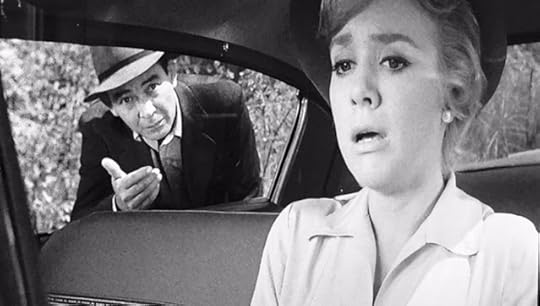
I stand before you as a man who’s been arrested, charged, prosecuted and found guilty of
being a pedestrian. Admittedly I was a pedestrian on the hard shoulder of a motorway, and
it’s a long story but it was a fair cop. I went quietly. Hitchhiking was involved, as was the
style at the time. I’ll spare you the rest of my ‘hitch-hiking stories.’
Now consider the case of Hassan Mansoor Mohammed Ameen who was found walking in the middle of a busy road at the junction of Esplanade Drive and Fullerton Road in Singapore in August 21st, causing cars to slow down or stop.
It seems like one of those stories you can never quite get to the bottom of, but it sounds as though the police tried to arrest him or at least get him off the road but he resisted. Complications ensued.

The following account comes from the Singaporean website Stomp, ‘The officer told Hassan he would be placed under arrest if he did not move off the road. When he did not comply, the officers called for backup.
‘After another four officers turned up, Hassan continued to ignore instructions to get off the road.
‘Director of Public Prosecutions Iranian said: ‘The accused also adopted a fighting stance at one point, shouted repeatedly and told the police officers that they were fake police officers.’
‘When they tried to arrest Hassan, he behaved aggressively and swung his hands wildly. He pushed an officer on the chest and swung his right arm and hit another officer on the right side of his face. Another officer then tasered Hassan. He fell down briefly but managed to get up and remove the probes from his body. Hassan then punched one of the officers before running off against the flow of traffic with the officers in pursuit. When they caught up with him, Hassan, who had taken off his top by then, continued to resist arrest. He was finally arrested after being tasered again.”
Well, that sounds like a lot of unnecessary bother, doesn’t it?
Hassan eventually had his day in court, and copped to everything. He admitted disorderly behavior, using violence on police officers, two counts of voluntarily causing hurt to deter public servants from their duties, one count of behaving in a disorderly manner on a public road, and one count of consuming methamphetamine. He was jailed on 30 December 2021, sentenced to one year and 29 weeks in jail.
The prosecution said he’d been taking meth weekly because he was 'bored and stressed about his personal life.' I have no idea what the defense said.
Well dude, going for a walk is a great way of alleviating boredom and stress, but not always a complete solution, obviously. As I recall I was fined 5 quid for my illegal motorway walking, though it was in the days when 5 quid was worth something.
January 7, 2022
ABIDE WITH ME, ETC
Here’s a picture of an old feller walking in Sheffield.

I took it about fifteen years ago when I was walking around the old neighbourhood where I grew up. It’s taken at the corner of Crowder Road and Crowder Crescent, and I’d have said it was on the Longley Estate, but it could be the Southey Green Estate: these things are finely nuanced and I’ve been gone a long time.
I don’t make any claims for myself as a photographer but I’m rather pleased with this one: the twisting of the trees contrasted with the bending of the old man. (Are they trees? I suppose they may be bushes or shrubs, but never mind). And for one reason another I decided to take a look on Google Street View to see what had been happening on that corner. This view, dated 2021, shows that the twisty trees are gone.

What a sad thing.
However, if you let Street View take you into the side street, Crowder Crescent, they’re still there. They’re not looking as healthy as in my pic but they’re hanging in there. But that picture is dated 2012.

So we can say that somewhere between 2012 and 2021 those trees were either removed or possibly they just died. It seems a sad thing but it may be nature taking its course.
The old man, I assume, is long, long gone.
Geoff Nicholson's Blog
- Geoff Nicholson's profile
- 55 followers





